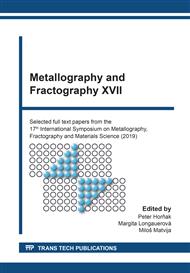p.391
p.396
p.402
p.411
p.417
p.423
p.430
p.435
p.440
Microstructure Characteristics, Tribology and Nano-Hardness of HVOF Sprayed NiCrRe Coating
Abstract:
The high-velocity oxy-fuel technique (HVOF) was used to produce dense NiCrRe coating on boiler steel substrate with a minimal amount of oxide impurities and low porosity. Microstructure analysis, tribology and nano-hardness measurement have been realized with the aim to characterize the systems. The microstructure was studied using scanning electron microscopy and Energy-dispersive X-ray spectroscopy. Tribological characteristics have been studied under the dry sliding condition at applied loads of 5, 10 and 20 N using the ball-on-flat technique with SiC ball at room temperature. Nano-hardness was investigated in continuous stiffness measurement (CSM) mode, the indentation depth limit was 1500 nm. Microstructure analyses proved that the HVOF sprayed layer, with a thickness approximately 870 µm, contains a relatively low volume fraction of porosity with a chemical composition based on Nickel, Chromium, with white areas of Rhenium. The wear rate of the coating is significantly lower than the wear rate of 16Mo3 steel. The average values of indentation modulus and hardness were EIT = 237.6 GPa and HIT = 6.3 GPa, respectively.
Info:
Periodical:
Pages:
435-439
Citation:
Online since:
November 2020
Keywords:
Price:
Сopyright:
© 2020 Trans Tech Publications Ltd. All Rights Reserved
Share:
Citation:


